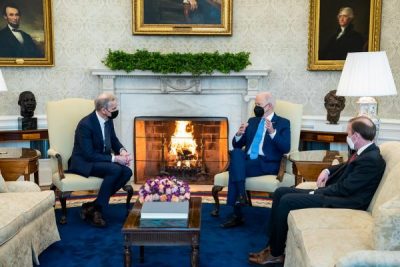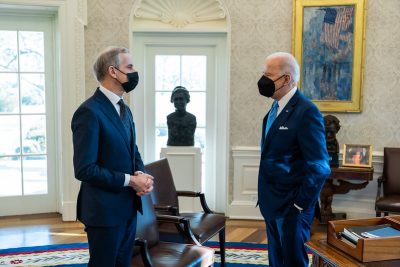NEWS ANALYSIS: Jonas Gahr Støre’s new government got off to an historically poor start last fall, but he managed to climax his first 100 days as prime minister with a fireside chat in the Oval Office. Last week’s impromptu meeting with US President Joe Biden crowned a week of high-level diplomacy, which has always been Støre’s greatest strength.

Norwegian media outlets have been full of coverage about Støre first 100 days as prime minister, and all their disappointments. His administration has had to bounce from crisis to crisis, while his Labour Party has suffered remarkably low standings in public opinion polls.
It was therefore a huge upturn when Støre suddenly found himself being ushered into a meeting with the US president. It takes most Norwegian leaders a long time to get an invitation to the White House, if at all, and it’s an occasion that attracts lots of media coverage. Støre’s meeting with Biden was so spontaneous that Norwegian media had no time for so-called “curtain raiser” coverage, and it missed a prime-time spot on national newscasts in Norway on Thursday evening because of time zone issues.
“If Labour had promised in its 100-day plan that Støre would be sitting together with the USA’s president, in front of a fire in the Oval Office by the end of January, they would have been laughed at, and with good reason,” wrote political commentator Hege Ulstein in newspaper Dagsavisen during the weekend. “But it actually happened.”
Despite the lack of front-page coverage, the meeting was still a major accomplishment for Støre and a reflection of how a small country like Norway plays an important role in much larger countries’ dealings with Russia. Until NATO started expanding in the 1990s, Norway was its only member country bordering on the Soviet Union until it collapsed and was replaced by the Russian Federation. Now its authoritarian president, Vladimir Putin, is desperately trying to keep as many of Russia’s remaining non-NATO neighbour countries, federated or not, under his control.
Norway, meanwhile, has managed to retain fairly good relations with Moscow, even at the chilliest times of the Cold War. A veteran US diplomat who spent much of the 1970s and ’80s in former East Bloc countries once said that the Americans could learn more about what was going on amongst Cold War adversaries in Oslo than they could in Moscow itself.

Støre, who started working for former Norwegian Prime Minister Gro Harlem Brundtland in 1989, has long been active in foreign policy at the highest levels. He played a major role in developing and negotiating Norway’s trade agreement with the EU, was involved in Middle East peace talks and served as chief of staff for Brundtland when she headed the World Health Organisation (WHO) in Geneva. He then served as secretary general of the Norwegian Red Cross until former Norwegian Prime Minister Jens Stoltenberg (now NATO’s secretary general) appointed him as foreign minister when Labour won the national election in 2005. Labour won again in 2009 and Støre stayed on, surviving a terrorist attack in Kabul and, not least, paying special attention to what he calls “nordområdene,” Norway’s northernmost territories in the Arctic, both on land and at sea and including the Russian border area.
The latter is where Støre has special expertise, with newspaper VG reporting during the weekend that it was such expertise that US President Joe Biden was keen on tapping. Biden wanted to hear about Norway’s experience with Russia as a neighbour and how Russia and Norway agreed on where their own border should be drawn in the Barents Sea, the so-called delelinjen (dividing line) that Norway and Russia drew in 2010.
Støre was already in the US last week to lead a session of the UN Security Council, on which Norway holds a seat through the rest of this year. Støre’s turn at the council president’s podium came just as Norway’s foreign ministry was hosting surprise talks with the Taliban back home in Oslo, and Støre could both explain his government’s initiative for the talks and report on their progress.
He then traveled from the UN in New York to Washington DC, where he’d already been invited for, among other things, a meeting with Biden’s National Security Adviser Jake Sullivan. That was a fairly big deal in itself, and then both Støre and Sullivan were called in to chat with Biden himself. The invitation was spurred by the pressing security issues surrounding Russia’s current and highly controversial troop build-up along Ukraine’s border, but it’s also an indication that Biden wanted to hear Støre’s take on it.

They’d met before, but not as leaders of their respective governments. Both Støre and Biden have long experience in foreign affairs. Støre described Biden as probably the US president with the longest such experience, much more than any earlier occupant of the Oval Office. And now he wanted to hear about Norway’s experience and, specifically, Støre’s.
“That’s where Støre shines,” wrote political commentator Ulstein, who also noted that Støre had been interviewed earlier in the week by CNN’s veteran foreign affairs journalist Christiane Amanpour on the conflict over Ukraine. That was another indication that Norway, and Støre in particular, has something to offer when conflicts with Russia arise. Ukraine has also been “high on the list,” Støre told foreign correspondents in Oslo earlier this month, of what he sees as the most important issues in Norway.
“It’s serious with our location (on the border to Russia just east of Kirkenes) and we are concerned about stability and security in our region,” Støre told the correspondents. “At the same time, Russia has the same right (to ensure its security). We need to avoid escalation.” His mantra in Norway’s Arctic areas has long been “high north, low tensions.”
Three weeks later, after his meeting with Biden, Støre told VG that he had the impression that the US is once again “open and listening” to its allies like Norway: “The fact that he’d clear his agenda for a meeting with me is a reflection of that, and that’s good.”
He also predicted yet another meeting between US Secretary of State Anthony Blinken and Russia’s veteran Foreign Minister Sergey Lavrov, in an effort to settle the conflict over Ukraine. On Monday Russian state news bureau TASS announced the two would have a phone conversation on Tuesday. “Biden himself is engaged and I think he’s open to take the conversation also at his level, if there’s a reason to do so,” Støre told VG, adding, though, that Biden is “standing firm on his principles that you can’t force other countries to do things against their will, that things have to happen through dialogue.”
Then Støre flew home to once again face all kinds of domestic issues in Norway that may seem unimportant compared to international politics and the balance of powers. He was back on nightly newscasts Sunday, promising more attention to development of offshore wind power. There’s also controversy over the pending reversal of forced county mergers, protests over record high electricity rates and ongoing power struggles within his own Labour Party, to name a few. It all illustrates the huge spectrum of issues that top politicians need to address, and how Støre can be brilliant at the international policy level but have trouble leading at the local level.
“It may sound strange, but it’s not necessarily so that Ukraine is more important than Viken (the huge new merged county that many, including Støre’s government, want to break up again),” wrote commentator Ulstein. “A quarrel over county borders in Norway can mean more for Labour’s future than an armed border conflict in Europe.” Støre can shine in conversations with other international leaders like Biden, but not on nagging issues at home where he’s often seemed much more on the defensive than on the offensive.
Ulstein could note, in Støre’s defense, that almost all the promises made by Støre in his 100-day plan were met by the minority coalition government he leads with the Center Party. The government has also offered households and farmers compensation for high electricity bills, extended compensation for those hit hardest by the pandemic, relaxed pandemic-related restrictions and on the verge of relaxing them even more this week. Norway’s economy is also rebounding, with unemployment down and business prospects up. Both Labour and Center should be performing better in the polls, but then so, arguably, should Biden.
It all illustrates, Ulstein notes, the enormous span of issues that government- and party leaders need to face on a daily basis. From global war and peace, the climate and future of the planet and international power grabs to seemingly unimportant local squabbles. The latter, however, mean a lot to voters, and can seal the political fate of men like Støre and Biden.
newsinenglish.no/Nina Berglund

